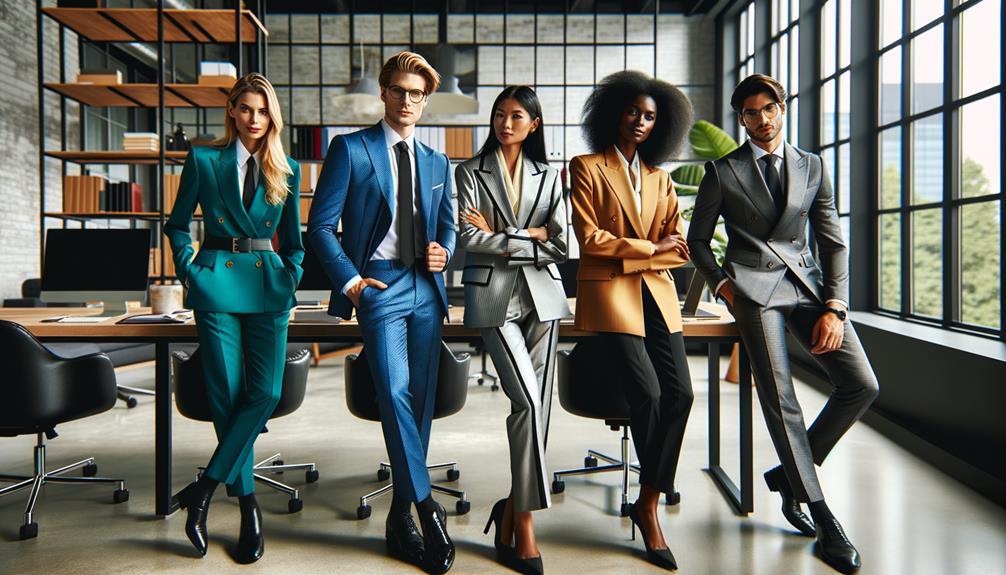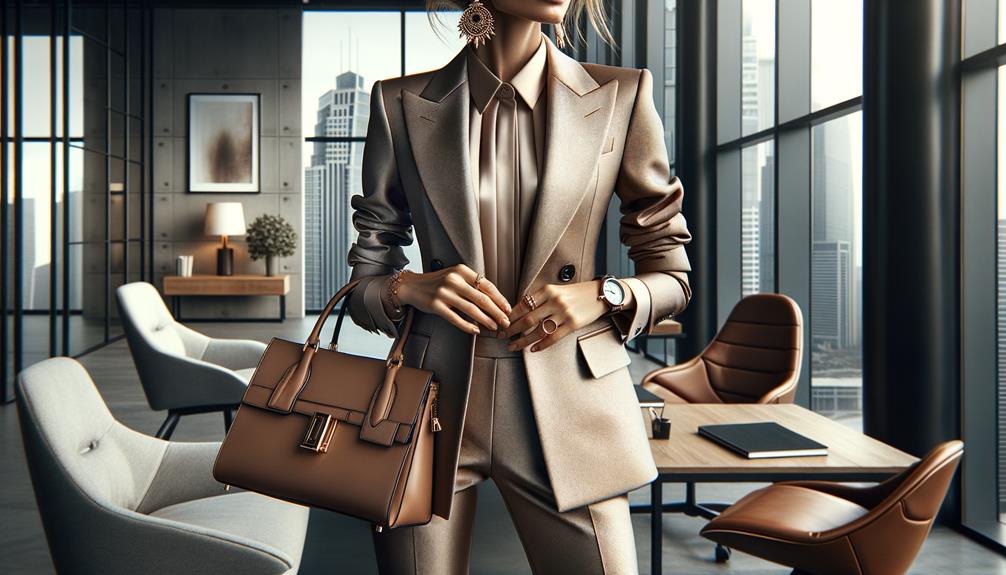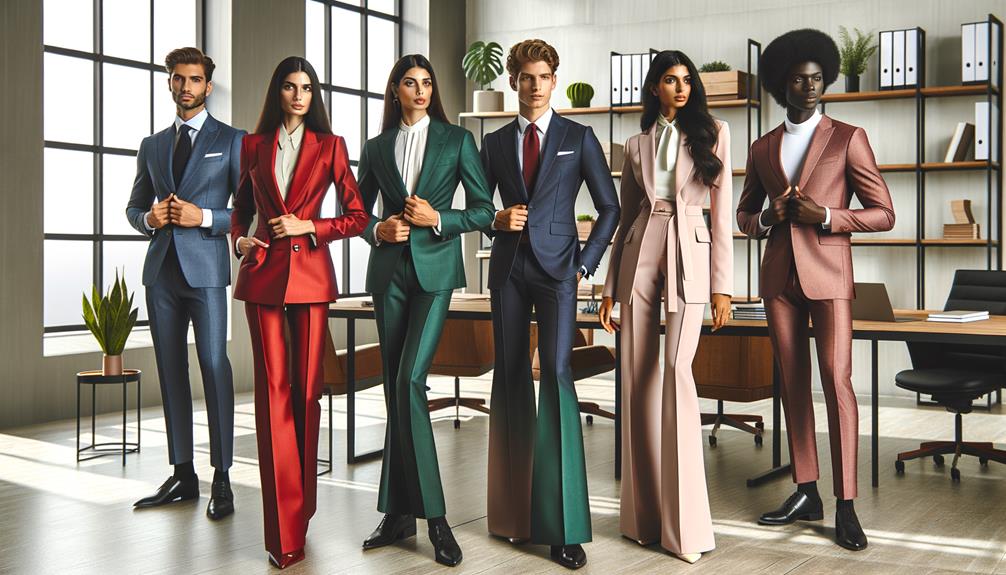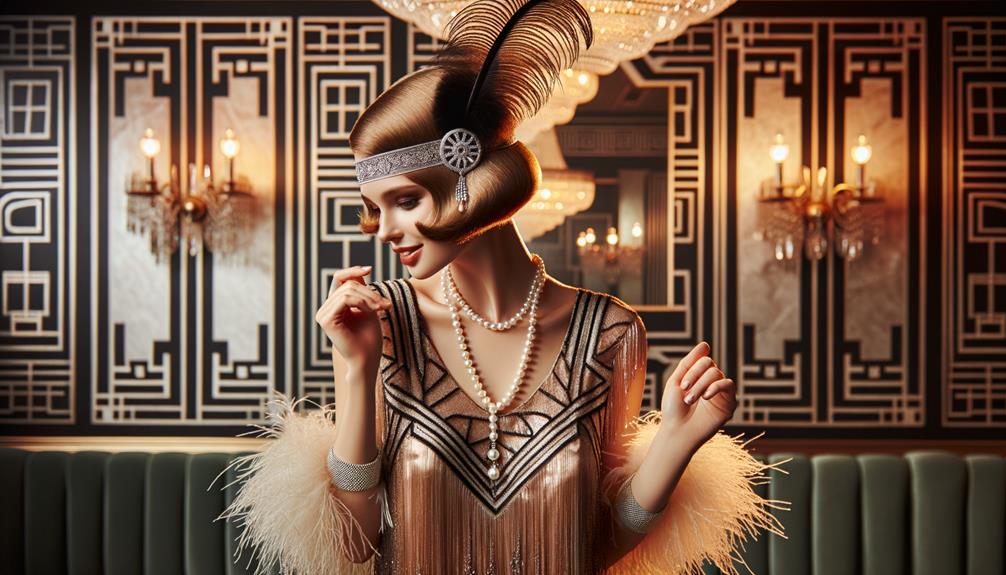The 1980s power suits radically transformed workwear, blending bold authority with refined elegance. Coco Chanel's early designs laid the foundation, but it was the sharp tailoring and confident silhouettes from designers like Hugo Boss and Calvin Klein that truly revolutionized professional wardrobes. Popular TV shows like Dynasty further popularized the big-shouldered look, symbolizing strength and ambition in the workplace. These suits weren't just about fashion; they challenged traditional gender norms and redefined what it meant to be a professional woman. As the era progressed, the nuances of empowerment and self-expression became firmly stitched into every suit.
Origins of the 1980s Power Suit
Although the 1980s power suit became iconic in that decade, its origins can be traced back to Coco Chanel's pioneering designs of the 1920s. Chanel envisioned a future where women could enter the workforce with the same authority as men. Her innovative spirit led to the creation of the first power suit – a jacket and skirt ensemble crafted from comfortable materials. Chanel wanted women to move freely, symbolizing not just fashion but empowerment.
Reflecting on Chanel's impact, the power suit was more than just clothing; it was a statement. By the 1970s, the pantsuit emerged as a bold symbol of a serious woman entering traditionally male-dominated spaces. This evolution wasn't just about fabric and design – it was about asserting power and claiming a rightful place in the professional world.
Tracing the journey from Chanel's innovative spirit to the exaggerated styles of the 1980s, there is a thread of resilience and transformation. The power suit evolved, but its core message stayed the same: women can hold power and wear it proudly.
Key Designers and Brands
When I think of the 1980s power suit, I'm struck by how influential top fashion houses like Hugo Boss, Kasper, and Calvin Klein have shaped our idea of professional attire. Each designer brought a distinct vision – Hugo Boss's sharp tailoring, Kasper's textured elegance, and Calvin Klein's minimalist approach. It's fascinating to see how these iconic styles continue to influence modern workwear, blending strength and sophistication.
Hugo Boss's suits were known for their precise cuts and crisp lines, projecting a sense of authority and confidence. Kasper, on the other hand, focused on luxurious fabrics and intricate detailing, elevating the power suit to an artform. Calvin Klein, meanwhile, pioneered a streamlined, pared-back aesthetic that became synonymous with modern professionalism.
These designers' contributions have endured, with their timeless silhouettes and design principles reverberating through today's office fashion. The 1980s power suit has evolved, but its core elements of structure, sophistication, and self-assurance remain influential, shaping how we define success in the workplace.
Influential Fashion Houses
In the world of fashion, iconic houses like Chanel and Saint Laurent have crafted more than just women's suits – they've created symbols of empowerment and professional identity. Their power suits have left an indelible mark on the industry, transforming how women perceive themselves in the workplace. Chanel's elegant yet structured designs and Saint Laurent's bold, androgynous approach offered women a sense of authority and sophistication.
Giorgio Armani's contributions in the 1980s were groundbreaking. His tailored trouser and skirt suits subtly disguised a woman's figure, providing an aura of authority without sacrificing style. This nuanced shift redefined women's workwear, making it both powerful and chic.
These fashion houses' influence extends beyond aesthetics. Hillary Clinton's frequent use of pantsuits as a visual statement in her political career emphasized both her difference from and familiarity with her male counterparts. Anna Wintour's penchant for elaborate patterns and prints further illustrates the growing diversity in professional attire.
Emerging designers like Jason Wu and RVNG Couture continue to innovate, blending professionalism with personal style. They offer relaxed, breathable, and sustainable options that echo the spirit of the original power suits.
Iconic Suit Designers
Few designers have left as profound an impact on the evolution of women's power suits as Coco Chanel and Giorgio Armani. In the 1920s, Chanel pioneered a comfortable yet stylish jacket and skirt combination that conveyed strength and energy. Her vision wasn't merely about appearances, but about empowering women through fashion.
Armani then took the reins in the 1980s, introducing tailored trouser suits that subtly disguised the figure, allowing women to command authority in the workplace. The wide-leg trousers, in particular, became a symbol of modern professional women.
As I reflect on these iconic designers and brands, several key contributions stand out:
- Coco Chanel: Introduced the modern power suit, blending comfort with an energetic appearance.
- Giorgio Armani: Revolutionized the tailored suit, emphasizing authority and professionalism.
- Anna Wintour: Broke traditional norms with bold patterns and prints.
- Jason Wu: Blended comfort with professionalism using loose-fitting pantsuits.
- RVNG Couture: Focused on sustainability with breathable, structured suits.
These designers didn't just shape trends; they redefined how women's power and fashion intersect, echoing the evolving landscape of workwear.
Signature Power Suit Styles
As I reflect on the pioneering work of Chanel and Armani, I'm struck by how today's designers continue to innovate with signature power suit styles that blend tradition and modernity. In women's fashion, labels like BOSS by Hugo Boss, Kasper, Calvin Klein, ASTR the Label, and Karl Lagerfeld Paris are leading the charge.
BOSS by Hugo Boss offers a classic power suit, featuring a tailored blazer with a notched collar and slim-leg ankle pants in luxurious virgin wool. It's a perfect blend of timeless elegance and contemporary style. Kasper, on the other hand, brings a touch of texture with its tweed-woven power suit, showcasing a cut-out stand collar blazer paired with a coordinating pencil skirt – a refined yet bold statement.
Calvin Klein's scuba crepe power suit stands out with its stand collar jacket and slim-leg elastic back pants, merging comfort with sharp tailoring. ASTR the Label redefines contemporary chic with a v-neck button-up vest top and wide-leg trousers, embodying a modern twist on the traditional suit.
Iconic Power Suit Moments
Reflecting on history, the 1980s power suit stands out as a pivotal symbol of women's evolving roles in the professional sphere. It wasn't just about fashion; it was a statement of empowerment. The exaggerated shoulder pads and tailored silhouettes allowed women to navigate male-dominated environments with newfound confidence.
Iconic moments in power suit history have left a lasting impact:
- Chanel's 1920s suits were energetic and strong, enabling women to enter the job market.
- 1970s pantsuits signaled the serious professional woman.
- 1980s TV shows like Dynasty popularized the big-shouldered jacket, cementing the power suit's place in pop culture.
- Hillary Clinton's campaign suits bridged gender gaps in politics.
- Anna Wintour's bold patterns challenged workplace dress codes, showcasing fashion's evolving nature.
These moments reflect how power suits have adapted to societal changes, moving beyond mere garments to symbols of progress. While accessibility has increased through fast fashion, true empowerment allows women to feel powerful in any attire, not just the iconic power suit.
Influence on Modern Workwear

When I look at the workwear we see today, it's fascinating to see how the bold fashion statements of the 80s have evolved. Trends now embrace vibrant colors, diverse silhouettes, and gender-neutral styles that challenge traditional norms. This progression feels natural, reflecting our society's broader push for inclusivity and self-expression.
Workwear has come a long way from the power suits of the past. Nowadays, the fashion we see in offices and workplaces celebrates diversity, allowing people to express their individuality through their attire. Gone are the days of rigid, one-size-fits-all dress codes. Instead, we're seeing a embrace of colorful, fluid styles that cater to a wide range of personal preferences and identities.
This shift in workwear mirrors the changes happening in our culture. As we strive for more inclusive and accepting environments, the clothes we wear to the office are also becoming a canvas for self-representation. It's an exciting time, where we can use fashion as a tool to challenge traditional notions of professionalism and gender.
The modern workwear landscape encourages people to show up as their authentic selves, rather than conforming to narrow expectations. This feels like a natural progression, one that aligns with our society's growing emphasis on embracing diversity and empowering individual expression.
Evolving Fashion Trends
How fascinating to see the once rigid power suit transform into a vibrant, inclusive, and sustainable staple of modern workwear. The evolution of fashion trends has truly revolutionized how we perceive professional attire. Gone are the days when power suits were confined to monochromatic palettes of black, grey, and navy. Today, they're a kaleidoscope of burgundy, emerald, and cobalt, reflecting a broader spectrum of self-expression.
In my observations, the focus on standout fashion is particularly significant. Designers are increasingly incorporating eco-friendly materials like organic cotton, Tencel, and recycled polyester, marking a substantial shift towards more responsible production practices. This commitment to sustainability resonates deeply with a generation that values environmental stewardship.
From oversized blazers to fitted jackets, there's something for every body type. More brands are offering a broader range of sizes and cuts. Traditional and contemporary elements blend seamlessly, and belts, scarves, and bold jewelry add a personal touch. A growing emphasis on sustainable fabrics and ethical production is also evident.
This nuanced transformation in power dressing is both a reflection of, and a catalyst for, a more inclusive and innovative workplace culture.
Gender-Neutral Styles
In today's workplaces, gender-neutral power suits are reshaping how we express our identities through professional attire. This shift is more than just a fashion trend; it's a movement towards inclusivity and authenticity. I've noticed how oversized blazers and relaxed trouser silhouettes are becoming the norm, blending traditionally masculine elements into women's workwear.
Take Hillary Clinton, for instance, whose iconic pantsuits have long symbolized power and professionalism. Her style choices have paved the way for a more fluid interpretation of workwear, one that allows us to move beyond restrictive gender norms. The fusion of masculine and feminine design elements in power suits lets us blend personal style with professional identity, creating a space where our attire feels like a true reflection of who we are.
Brands are responding to this demand, offering a broader range of sizes and inclusive cuts. This not only caters to diverse body types but also promotes a sense of belonging and self-acceptance. The rise of gender-neutral power suits is an affirmation of a progressive workplace culture where we can all feel empowered, authentic, and respected.
Styling and Accessories

Accessories can transform a simple suit into a personalized expression. The right add-ons can make a big difference – it's not just about looking professional, but infusing your unique style. Small details in accessorizing can add depth and intrigue to an otherwise straightforward outfit.
Consider these accessories that can elevate your look:
- Statement belts with eye-catching designs or buckles
- Vibrant scarves and ties with meaningful patterns
- Bold, minimalist jewelry like statement earrings or chunky bracelets
- Each accessory should convey your creativity and personal flair
- Versatile shoes that can seamlessly transition from the office to after-work events
These accessories are the brushstrokes that allow you to showcase your confidence and originality. A scarf or tie can tell a story, while bold jewelry can empower you to stand out. In a world of uniformity, these thoughtful touches are where true style shines through.
Cultural and Social Impact

While accessories can personalize and elevate the power suit, it's the cultural and social impact of this iconic attire that truly redefines its significance in our collective narrative. The power suit has shifted from a traditionally masculine ensemble to an emblem of female empowerment, breaking down long-established gender norms in professional settings. When I see women donning these structured silhouettes, I can't help but think of trailblazers like Hillary Clinton, who used power suits to signal competence and authority.
Moreover, the evolution of power suit designs – featuring vibrant colors, bold patterns, and inclusive sizing – speaks volumes about our shifting values. It's not just about fitting into a corporate mold anymore; it's about expressing individuality and embracing diversity. This fusion of fashion and professionalism blurs the lines between traditional work attire and personal style, making workwear a canvas for self-expression.
In today's world, the emphasis on sustainability has brought eco-friendly power suits into the spotlight. These options cater to the growing demand for ethical and environmentally conscious clothing, proving that innovation in fashion can align with our social responsibilities. The power suit is no longer just a uniform; it's a statement.
Frequently Asked Questions
What Is the Difference Between a Power Suit and a Regular Suit?
Power suits and regular suits convey different impressions. Power suits exude authority with their bold colors and sharp tailoring, making a strong statement. They feel like a declaration of confidence and influence. In contrast, regular suits are more about blending in and adhering to tradition. They project a sense of professionalism and conformity, rather than standing out. The visual differences between the two types of suits reflect the varying messages they send about the wearer's persona and aspirations.
Who Created Power Suits?
Power suits, as we know them today, emerged from the fashion revolution spearheaded by Coco Chanel in the 1920s. Chanel's vision went beyond mere clothing trends – it was a bold statement that empowered women, infusing them with a sense of strength and elegance. This revolutionary approach challenged the traditional norms and paved the way for women to assert their presence in the professional sphere with confidence and style.
Chanel's power suits were a departure from the constrictive and ornate fashions of the past, embracing a more streamlined and functional aesthetic. By incorporating masculine elements like structured shoulders and tapered waists, she imbued her designs with a sense of authority and capability. This allowed women to express their ambition and competence through their attire, rather than being confined by societal expectations.
The success of Chanel's power suits demonstrated the significant impact fashion can have on perceptions and social dynamics. These garments became a symbol of the changing role of women in society, challenging gender stereotypes and providing them with a sartorial tool to assert their rightful place in the professional landscape. Chanel's revolutionary vision continues to resonate today, as power suits remain a staple in many modern workplaces, empowering women to showcase their strength and poise.
What Color Suit Is a Power Suit?
When I think about power suits, it's clear they've evolved beyond the traditional black, gray, or navy. Vibrant shades like deep emerald, rich burgundy, and cobalt blue are now commanding attention in the workplace. These bold colors convey a sense of authority and confidence that goes beyond the conventional. The power suit has truly diversified, empowering individuals to express their personal style while projecting an image of leadership and success.
What Is Power Dressing Today?
Power dressing today has evolved beyond the traditional notions of formal business attire. It now embraces vibrant colors, bold silhouettes, and a more inclusive approach. The focus is on sustainable, high-quality garments and expressive accessories that blur the lines between fashion and professionalism. This transformation has allowed individuals to showcase their personal style while maintaining a polished, confident presence in the workplace.
Conclusion
Looking back, the bold power suits of the 1980s were more than just fashion – they were statements of strength and sophistication. Designers pushed the boundaries, creating iconic images that still influence our wardrobes today. Witnessing the evolution of workwear from those bold beginnings is truly fascinating. The sharp shoulders, sleek silhouettes, and subtle style cues continue to shape our sartorial choices, proving that some trends truly stand the test of time.



